Here we are providing Class 12 Geography Important Extra Questions and Answers Chapter 8 Manufacturing Industries. Geography Class 12 Important Questions are the best resource for students which helps in class 12 board exams.
Class 12 Geography Chapter 8 Important Extra Questions Manufacturing Industries
Manufacturing Industries Important Extra Questions Very Short Answer Type
Question 1.
When was TISCO at Jamshedpur established ?
Answer:
In 1907.
Question 2.
Classify industries on the basis of ownership.
Answer:
Public Sector, Private Sector and Cooperative Sector.
Question 3.
What is the total production of steel in India ?
Answer:
76.7 million tonnes.
Question 4.
When and where was the first modern cotton textile mill setup ?
Answer:
In 1854 in Mumbai.
Question 5.
State the number of total sugar mills in India.
Answer:
526.
Question 6.
What is the total production of sugar in India (2012) ?
Answer:
339 million tonnes.
Question 7.
Name the largest centre of electronic industry in India.
Answer:
Bengaluru.
Question 8.
Name two industrial centres of Chotta Nagpur region.
Answer:
Ranchi and Bokaro.
Question 9.
Classify industries on the basis of raw materials.
Answer:
Agro-based, Forest-based and Mineral-based industries.
Question 10.
On what factors does the Cotton textiles depend ?
Answer:
- Raw materials
- Fuel
- Chemical
- Machinery
- Labour
- Transport
- Market.
Question 11.
Name the five main points of Pentagon formed by major centres of cotton textiles.
Answer:
Ahmedabad, Mumbai, Solapur, Nagpur, Indore, Ujjain.
Question 12.
Which state has the highest number of cotton textile mills ?
Answer:
Tamil Nadu—439 mills.
Question 13.
Give one example each of Ferrous and non-Ferrous industries. (Sample Paper 1)
Answer:
Ferrous—iron and steel, non-Ferrous-Copper.
Question 14.
Name any two sub-sections of cotton textile industry in the world. (C.B.S.E. 2009)
Answer:
(i) Handloom
(ii) Mill Sector.
Question 15.
Name the two rivers that provide water to Tata Iron and Steel Company (TISCO). (C.B.S.E. 2013)
Answer:
Khorkai and Subarnarekha.
Manufacturing Industries Important Extra Questions Short Answer Type
Question 1.
Name the industries classified on the basis of raw materials.
Answer:
- Agro-based industries
- Forest-based industries
- Mineral-based industries
- Assembling industries.
Question 2.
Name the industries classified on the basis of entrepreneurship.
Answer:
(i) Public Sector Industries
(ii) Private Sector
(iii) Co-operative Sector.
Question 3.
Describe five features of distribution of cotton textile industry in India.
Answer:
(i) Cotton Textile is widely distributed in India.
(ii) It is concentrated in Mumbai, Ahmedabad.
(iii) It is an agro-based industry
(iv) Cloth is produced in three sectors
- Mills
- Power-looms
- Handlooms
(v) It is the largest industry in India.
Question 4.
What do you mean by “manufacturing” ?
Answer:
Manufacturing is the process of conversion of raw materials into useful finished products with the help of machines. It is a secondary occupation of man. Manufacturing has a major role in utilisation of resources as these transform resources into more valuable goods. For example, wood pulp and paper are manufactured from wood, yarn and cloth from cotton, steel and machine tools from iron ore.
Question 5.
What is heavy industry ?
Answer:
The industries using minerals for manufacturing bulky products are known as heavy industries. Thus, heavy industries are mineral-based. The products are manufactured in modern mills. These form the basis of industrialisation of a country. Iron and steel, Machine tools, Engineering industries are included in this category.
Question 6.
In what different ways, can industries be classified ?
Answer:
The industries can be classified on the following basis:
(i) On the basis of size of the industries, the industries can be classified into two categories:
- Large-scale industries.
- Small-scale industries.
(ii) On the basis of development of the industries, the industries are of two types:
- Cottage industries.
- Mill industries.
(iii) On the basis of ownership, the industries fall into three groups:
- Public sector.
- Private sector.
- Cooperative sector.
(iv) On the basis of raw materials, industries are mainly of two types :
- Agro-based industries.
- Mineral-based industries.
(v) On the basis of manufactured goods, the industries are of two types :
- Heavy industries.
- Light industries.
(vi) Similarly different types of industries are grouped as handicrafts, village industries, household industries, key industries and consumer industries.
Question 7.
Name the five iron and steel towns of India.
Answer:
Iron and steel plants are established in the following towns which are known as steel towns of India.
- Jamshedpur (Jharkhand)
- Bokaro (Jharkhand)
- Bhilai (Chhattisgarh)
- Rourkela (Odisha)
- Durgapur (W. Bengal)
Question 8.
State the different sectors on ‘the basis of structure of industries. (C.B.S.E. 2013)
Answer:
On the basis of ownership, the industries are grouped into three sectors:
(i) Public Sector. These are managed by the state. These are basic and heavy industries. For example, Bhilai steel plant, Nangal fertiliser factory.
(ii) Private Sector. These industries run under the private management of individuals such as Jamshedpur TISCO steel plant.
(iii) Joint or Cooperative Sector. These industries are managed by a group of persons or a co-operative society. For example, sugar industries.
Question 9.
What are the problems of cotton textiles?
Answer:
Cotton textiles is the largest organised industry, but it has some problems.
- The production of long staple cotton is not large. India has to import long staple cotton
- The machinery is old and obsolete. Its productivity is low and cost is high
- Capital is required for modernisation of machinery particularly automatic machines
- Competition from China and Japan is hard.
Question 10.
Why have the textile industries moved from Mumbai towards Ahmedabad ? Explain with the help of suitable examples.
Answer:
The first modern cotton textile mill was established in Mumbai in 1854. Location of the Port, humid coastal climate, development of chemical industry, availability of capital and easy import of machinery were some of the advantages. Raw cotton was imported from other states. After some time, the dispersal of cotton textile industry started.
With the result, cotton mills were established at Ahmedabad, in the heart of cotton growing belt. At Ahmedabad, level land as well as capital was available. Ahmedabad has no problems of strikes, high wages. Therefore Ahmedabad became the ‘Manchester of India’ (the largest textile centre of India).
Question 11.
Why is iron and steel industry located only in Peninsular India ?
Answer:
Iron and Steel is a heavy industry using very bulky raw materials. Therefore, its location is governed by close proximity to raw materials and good transport system. The north eastern and southern parts of Peninsular India are rich in minerals which is suitable for the location of Iron and Steel industries.
Question 12.
Classify industries on the basis of manufactured products.
Answer:
Classification of industries is based on the nature of the manufactured products. Seven classes of industries, thus, identified are:
- Metallurgical Industries
- Mechanical Engineering Industries,
- Electrical Engineering
- Chemical and Allied Industries
- Textile Industries
- Food Industries, and
- Electricity Generation.
Electronics industries have emerged as the 8th group of industries.
Question 13.
Explain any three major objectives of New Industrial Policy of India, which was announced in 1991. (C.B.S.E. 2011)
Or
Mention any four major objectives of the New Industrial Policy, 1991 of India. Describe the role of globalisation in achieving these objectives. (C.B.S.E. Outside Delhi 2017)
Answer:
Industrial Policy. The new industrial policy was announced in 1991. The major objectives of this policy were:
- To build on the gains already made.
- To correct the distortions or weaknesses that have crept in.
- To maintain a sustained growth in productivity and gainful employment.
- To attain international competitiveness.
Question 14.
Describe the steps taken during Liberalisation Policy.
Answer:
New Industrial Policy of 1991 announced several liberalisation measures and private sector was destined to play an important role in industrial activities during the Eighth Five Year Plan (1992-1997).
- Major liberalisation measures removed entry barriers to investment
- opened trade
- provided free access to foreign technology in some sectors
- opened up foreign direct investment and
- removed barriers inhibiting access to capital markets.
Question 15.
Name the major industrial regions, minor industrial regions and industrial districts.
Answer:
Industrial Regions and Districts
Major Industrial Regions.
- Mumbai-Pune Region
- Hugli Region
- Bengaluru-Tamil Nadu Region
- Gujarat Region
- Chottanagpur Region
- Vishakhapatnam-Guntur Region
- Gurgaon- Delhi-Meerut Region, and
- Kollam-Thiruvan- thapuram Region.
Minor Industrial Regions.
- Ambala-Amritsar,
- Saharanpur-Muzaffarnagar-Bijnaur
- Indore- Dewas-Ujjain
- Jaipur-Ajmer
- Kolhapur-South Kannad
- Northern Malabar
- Middle Malabar
- Adilbad-Nizamabad
- Allahabad-Varanasi-Mirzapur,
- Bhojpur-Munger
- Durg-Raipur
- Bilaspur- Korba, and
- Brahmaputra valley.
Industrial Districts
- Kanpur
- Hyderabad
- Agra
- Nagpur
- Gwalior
- Bhopal
- Lucknow
- Jalpaiguri
- Cuttack
- Gorakhpur
- Aligarh
- Kota
- Purnia
- Jabalpur, and
- Bareilly.
Question 16.
List tha factors which favour the location of steel plant at Jamshedpur.
Answer:
Jamshedpur is ideally situated with respect to raw materials and market for the location of iron and steel industry. The plant has the following favourable facilities:
Geographical factors for location
- Availability of iron ore from Singhbhum region.
- Coking coal from Jharia and Raniganj.
- Limestone, Manganese and Quartz are available nearby.
- Damodar, Subamrekha, Kharkai rivers provide water and sand.
- Cheap labour from densely populated state of Bihar and West Bengal.
- Facilities of cheap transport and port of Kolkata.
- Water power is available from D.V.C.
Question 17.
Account for the concentration of cotton textiles at Mumbai and Ahmedabad.
Or
Mention any two factors responsible for the establishment of cotton textile mills in Mumbai. (CBSE2018)
Answer:
The first cotton textile mill in India was established in 1854 in Mumbai. A large home market, manufacturing of textile machinery and abundant supply of raw cotton has favoured the growth of this industry in India. There are 1050 mills scattered over 80 towns of India. India is the world’s largest cotton textile producer.
Mumbai is the oldest centre of cotton textile industry in India. Mumbai is known as ‘Cotton Polis of India’. The following factors have led to the concentration of this industry at Mumbai:
- Early start.
- Warm and humid marine climate.
- Nearness to cotton producing areas of Maharashtra.
- Easy import of machinery, chemicals, long staple cotton from the port of Mumbai.
- Cheap skilled labour.
- Water power from Tata Hydro Electric Works.
- Large ready market.
- Facilities of trade, banking and transport.
Ahmedabad (Gujarat) is the largest producer of cotton textiles in India. It is known as the ‘Manchester of India’. Ahmedabad is situated in the heart of cotton growing areas of Gujarat. Cheap land, water power and skilled labour is available. The combination of these factors have led to the growth of cotton textiles in Ahmedabad.
Question 18.
Describe any five characteristics of ‘Gujarat Industrial Region’. (C.B.S.E. 2009)
Or
Explain any five factors responsible for the development of “Gujarat Industrial Region.” (C.B.S.E. Delhi 2017)
Answer:
Gujarat Industrial Region.
This is the third largest industrial region of India. It is an inland industrial region and has the following favourable factors:
- It is located near the raw cotton producing area. It is close to the marketing centres of Ganga- Sutlej plains.
- Cheap skilled labour as well as cheap land is available.
- The discovery of oil in the Gulf of Cambay region has led to establishment of an industrial complex of petro-chemical industries.
- The development of new port of Kandla has provided the facilities of import-exports.
- Ahmedabad is the major centre of cotton textiles and is known as the Manchester of India’.
Question 19.
Why are sugar mills con¬centrated within the sugarcane producing areas in India ? Explain citing five reasons. (C.B.S.E. 2009) (Sample paper 2017)
Answer:
Maharashtra, Uttar Pradesh and Tamil Nadu are the major sugarcane producing states. Most of sugar factories are located in the above mentioned states. This is due to following reasons :
- Sugarcane is a weight loosing crop. Therefore sugar mills are located near sugarcane producing areas.
- It should be used immediately after harvesting otherwise its sucrose content begins to dry.
- Sugarcane must be crushed within 24 hours of harvesting to get better recovery of sugar.
- Transportation cost is avoided if it is transported to a short distance.
- Sugar mills are located in areas where sucrose content is very high.
Question 20.
Explain with examples the factors that helped in the development of Hoogli Industrial region.(Delhi 2019)
Or
Explain any five factors responsible for the development of Hoogli Industrial region. (C.B.S.E. Delhi 2017)
Answer:
Hoogli region is located along the Hoogli river to a distance of 100 kms. The following factors favour the development of the Hoogli region.
- Opening of coal fields of Damodar Valley.
- Opening of rich port of Kolkata along the Hoogli river.
- Location of petroleum refinery at Haldia.
- Roads and railways provides subsequante lines to the great benefit of the region.
Question 21.
Study the following diagram and answer the questions that follow: (CBSE 2010)
(10.1) Identify and name the steel plant shown in this diagram.
(10.2) Name the mining fields which supply coal and limestone to this plant.
(10.3) Mention the source of water for this plant.
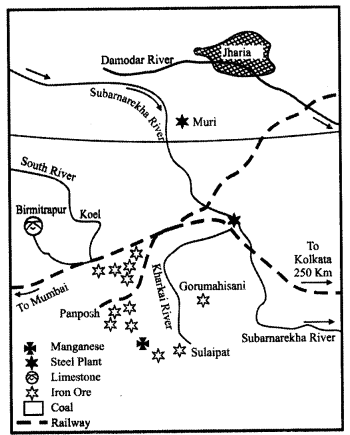
Answer:
(10.1) Jamshedpur steel plant
(10.2) Coal from Jharia, limestone from Birmitrapur
(10.3) Water from rivers Subarnarekha and Kharkai
Manufacturing Industries Important Extra Questions Long Answer Type
Question 1.
Explain the locational factors of Industries with the help of suitable examples. (C.B.S.E. 2013)
Or
Explain five main geographical factors influencing location of industries giving suitable examples from Indian industries.
Or
Why do large scale industries choose different location? Explain any four factors which influence the industrial location. (C.B.S.E. Delhi 2017)
Answer:
Manufacturing. Manufacturing is a secondary process of transforming raw materials into finished products. The raw materials of agriculture, forests, minerals are changed into new products. For example, clay is changed into pottery, timber is changed into furniture, etc.
These manufactured goods are more useful and valuable than the raw material. The location of manufacturing industries depends on a number of physical and socio-economic factors. These factors are called the basis of industries. No single factor decides the location of industries.
Geographical Factors
(1) Nearness to raw materials. Large quantities of raw materials are needed for industries. Therefore, industries are located near the source of raw materials. The industries are located near mines, forests, farms and seas. It saves the cost of transportation. Sugar mills are located in the areas where sugarcane is produced. Iron and steel industry uses bulky raw materials.
Steel centres are developed where coal and iron are easily available. Industries producing perishable goods (meat, fish and dairy products) are located near the areas of their production. Example. Jute mills in West Bengal and Cotton Textile mills in Maharashtra are located due to the availability of the raw materials.
(2) Power resources. Coal, oil and water-power are the main sources of power. Most of the industries are located around coal-fields. The industrial regions of Damodar Valley (India), Ruhr Valley (West Germany) depends upon coal. Some industries use large amount of electricity.
Such industries like Chemical Industries, Aluminium Industries and Paper Industry are located near hydro-electric stations. Petro-chemical Industries use large quantities of Petroleum. Example. Iron and Steel centres in India are located near Jharia and Raniganj coal fields. Chemical fertiliser plant is located at Nangal where cheap water power is available from Bhakra Project.
(3) Means of Transportation. Modern industries need cheap, developed and quick means of transportation. Water-transport is the cheapest means of transport. Cheap means of transportation are required for the movement of workers, raw materials and machinery to the factories. Manufactured goods should be sent to the market at low cost. Example. Delhi is the nodal point of transport and industries concentrated around it.
(4) Climate. Stimulating climate increases the efficiency of the labourers. Certain industries require special type of climate. Cotton Textile industry requires humid climate, Film industry needs good weather with clear blue sky. Areas with favourable climate become huge markets.
Example. Mumbai is the leading centre of Cotton Textile due to wet coastal climate. Dry climate has led to the location of Aircraft Industry at Bengaluru (India) and California (U.S.A.).
Non-Geographical factors
(5) Cheap land. Heavy industries need cheap level land. Steel industry at Jamshedpur is located in a broad river-valley.
(6) Capital. Large amount of capital is invested in many industries. Many industries have been located in big cities like Delhi, Mumbai, Kolkata. Many banks and companies provide capital in these areas.
(7) Skilled labour. Cheap and skilled labour is essential for the location of the industries. Areas of dense population provide cheap and large labour force. Engineering industries need skilled labour. Cotton Textile industry in Lancashire, Glass industry in Ferozabad, Sports goods industry in Jalandhar are located due to the availability of the skilled labour. The Swiss are known for watch making, the British for specialised cotton textiles, the Japanese for electronic goods and Varanasi is known for Silk embroidery.
(8) Government policies. Most of the industries are located with government aid. Government policies may encourage or discourage the industries in an area. Government may offer cheap land, reduce taxes, help in providing machinery and transport. Bhilai and Rourkela tea plants were set up to develop tribal area.
(9) Nearness to market. Industries are located near the market for their manufactured goods. Urban and industrial centres with dense population provide a large market. Market is based on demand and the purchasing power of the people. Countries of Asia do not make a huge market because the people cannot afford to buy goods. Dairy Industry is located near the ready markets of towns. Light Engineering industries are located near the big factories which require these goods.
(10) Early start. Momentum of an early start leads to the location of an industry such as cotton textile in Mumbai.
(11) Defence. Some industries are located with a military motive such as Aircraft industry at Bengaluru.
(12) Historical Factors. Historical accident may bring an industry to a new location such as Automobile Industry at Detriot in U.S.A., Lock Industry at Aligarh.
(13) Other Factors. Some secondary factors also help in the location of industries such as availability of water, technical knowledge, political factors, etc. The location of industries keep on changing. A good location, today may become a bad location tomorrow.
Question 2.
Describe the location and development of Iron and Steel Industry in India. (C.B.S.E. Outside Delhi 2017)
Answer:
Iron and steel industry is the basis of modern industrialisation. It is the foundation of modern machines, tools, transportation (rail, road, water, air). It is used in making super structures, bridges, tanks, agricultural implements and many products of daily use. It has great strength, toughness, elasticity and low cost of production. The production and consumption of steel is the index of the nconomic development of country.
Ours is truly an ‘Age of Steel.’
Factors for the location of Iron and Steel industry.
- Raw Materials. Iron and steel industry needs the bulky raw materials of manganese, limestone and scrap iron.
- Coking coal. Coking coal or charcoal is required for smelting of iron ore.
- Cheap land. Modern steel plants, furnaces require cheap level land.
- Market. The products of iron and steel industry demand a big consumer market.
- Capital. Iron and steel industry requires huge capital. Lack of capital is a main obstacle to this industry in the developing countries.
- Other Factors. Iron and steel industry needs cheap transport, skilled labour and modern techniques.
The first modern steel plant was established in 1907 at Sakchi (Jamshedpur) in Jharkhand, by Jamshedji Tata. India produces the cheapest steel in the world. India has large reserves of high grade iron- ore, coking coal and limestone. These raw materials are found close to each other. India produces 340 lakh tons of steel. With the establishment of new steel plants, it is expected to reach 500 lakh tons of steel.
Iron steel industry
Centres of Production.
I. Damodar Valley. This region has TISCO (Tata Iron and Steel Company) steel plant at Jamshedpur and IISCO (India Iron and Steel Company) steel plant at Kulti-Burnpur.
Geographical Factors for location.
- Availability of iron ore from Singhbhum region.
- Coking coal from Jharia and Raniganj.
- Limestone, Manganese and Quartz are available nearby.
- Damodar, Subamrekha, Kharkai provide water and sand.
- Cheap labour from densely populated states of Bihar and West Bengal.
- Facilities of cheap transport and port of Kolkata.
II. Visvesvaraya Iron and Steel Limited. This steel plant is located at Bhadravati (Karnataka). It produces alloy and special steel. Iron ore is obtained from Babaudan Hills, charcoal from Kadur forests, water power from Jog Falls, limestone from Bhandigudda mines.
III. Steel Centres in Public Sector. Four steel plants have been developed in the public sector, under HSL (Hindustan Steel Limited) with the collaboration of some foreign countries.
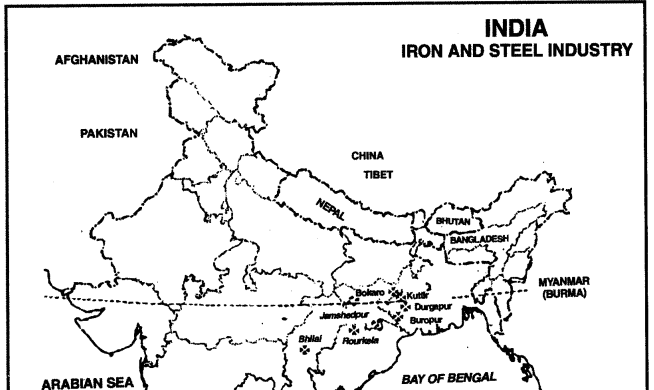
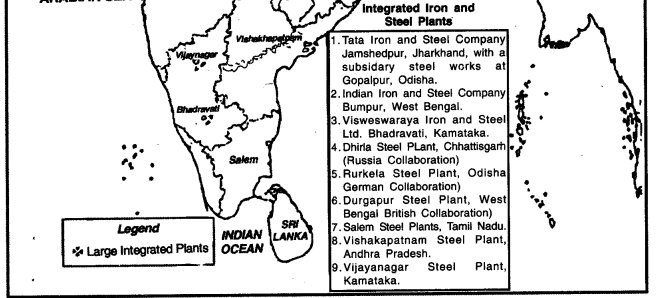
Bhilai (Chhattisgarh)—with the help of Russia.
- Vishakhapatnam (Andhra Pradesh)
- Salem (Tamil Rourkela (Odisha)—By German Firm Krupps- Demag.
- Durgapur (West Bengal)—With British aid.
- Bokaro (Jharkhand)—With Russian help.
Geographical factors for location:
- Bhilai gets iron ore from Dhalli Rajhara hills; coal from Korba and Jharia coal fields; manganese from Balaghat ranges and limestone from Nandani mines.
- Durgapur gets iron ore from Singbhum; coal from Raniganj; lime stone from Gangpur and water from D.V.C.
- Rourkela gets iron from Bonai; coal from Jharia and Raniganj, limestone from Birmittrapur.
- Bokaro, an ore based steel plant gets coal from Jharia; iron from Keonjhar and water power from D.V.C.
IV. New Steel Plants. The Govt, has set up new steel plants at:
(i) Vishakhapatnam (Andhra Pradesh)
(ii) Salem (Tamil Nadu)
(iii) Vijayanagar (Near Hospet, Karnataka)
The capacity of the different steel plants is being expanded. The production of pig iron and steel is being increased by setting up new mini plants based on scrap iron. At present there are 169 mini steel plants in India. India exports about 20 lakh tonnes of steel every year earning a foreign exchange of ₹ 2000 crores. In 1973, SAIL (Steel Authority of India Limited) has been established for the better management of these steel plants.
Question 3.
Describe the location and development of Cotton Textile Industry in India.
Answer:
Cotton Textile Industry
Cotton textile industry is one of the oldest industries in India. Spinning and weaving were the earliest crafts of primitive man. The industry owes its rapid development due to Industrial revolution, Many spinning and weaving machines were invented, These inventions changed this industry from a household to mill industry.
India has a glorious part of cotton textile industry. The first cotton mill was established in 1854 in Mumbai. A large home market, manufacturing of textile machinery and abundant supply of cotton have led to the growth of this industry in India. There are
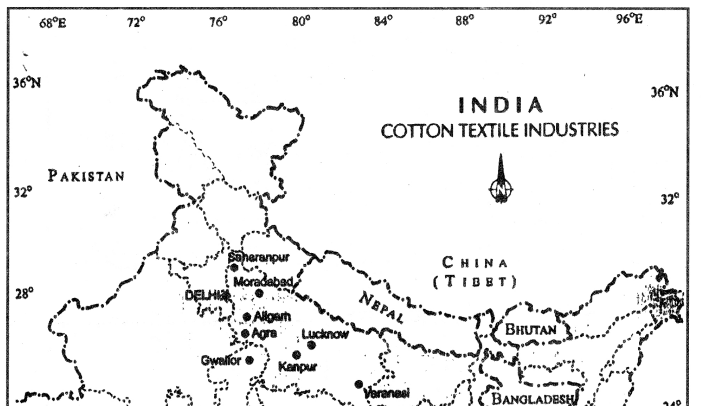
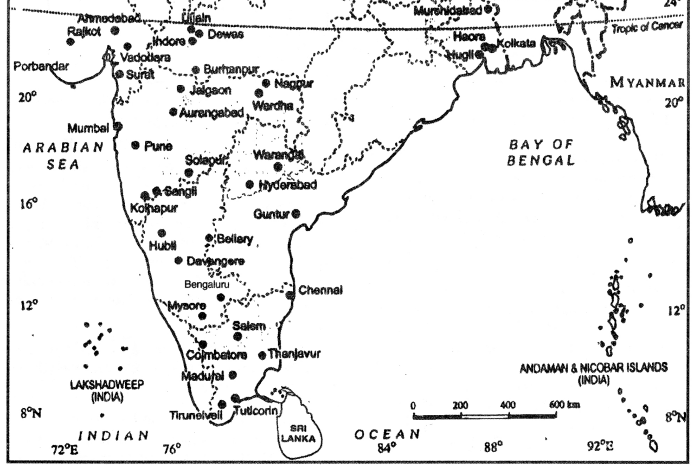
about 1824 textile mills scattered over 80 towns and the annual production of cloth is about 3000 crore metres. India is the second largest producer of cotton textile in the world.
Distribution of Cotton Textile Industry :
(i) Maharashtra. Mumbai is the oldest centre of cotton textile industry in India. Mumbai is known as “Cotton Polis of India.” Nagpur, Pune, Sholapur, Amaravati are other centres. The following factors have led to the concentration of this industry at Mumbai:
- Early start
- Large amount of capital
- Long staple cotton from Gujarat and Maharashtra
- Facilities of Mumbai as a port
- Easy import of machinery
- Humid climate
- Cheap labour
- Water power from Tata Hydro-electric works
- Large ready market
- Opening of Suez Canal route.
(ii) Gujarat. Ahmedabad is the largest producer of cotton textiles in India. It is known as the ‘Manchester of India’. Ahmedabad is situated in the heart of cotton growing area. Cheap land is also available.
(iii) Tamil Nadu. The development of hydro-electricity in the South and cul tivation of long staple cotton led to the location of this industry in Southern India. Madurai, Coimbatore, Salem and Chennai are the main centres.
(iv) West Bengal. Most of the mills are located at Kolkata in the Hugh basin.
(v) Uttar Pradesh. Kanpur is the main centre and is called ‘The Manchester of Northern India’.
(vi) The dispersal of this industry has led to the growth of new centres like Bhopal, Gwalior, Bengaluru, Phagwara, Bhiv/ani, Delhi and Kota.
Importance
- Cotton Textiles is the oldest and the biggest industry in India.
- About 10 lakh workers are engaged in this industry
- It has the largest amount of capital (X 1300 crores) invested
- It earns about a sum of X 8000 crores as foreign exchange by export of manufactured goods.
(v) Many industries such as dyes, chemicals, etc., depend on cotton products.
Question 4.
Describe the importance, location and distribution of Sugar industry in India.
Answer:
Sugar Industry. Sugar is an important article of food. It has a universal demand. Sugar is obtained from two major sources:
(a) Sugarcane
(b) Sugar beet.
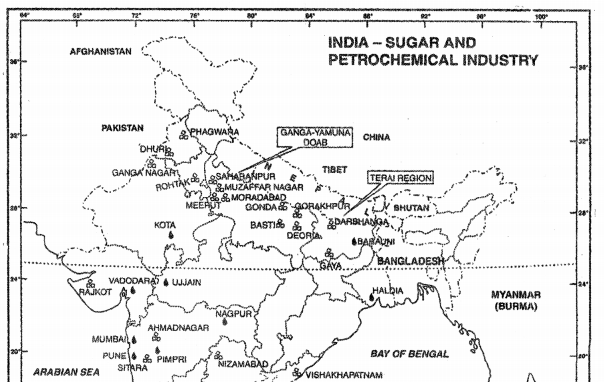
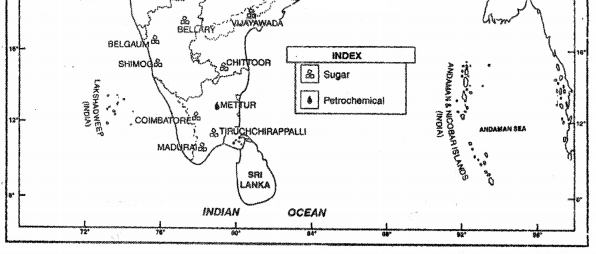
India is regarded as the birth-place of sugarcane and sugar. The tropical areas have the sugarcane industry, while the temperate regions have the sugar beet industry.
Importance:
- India is the largest producer of sugar in the world.
- It is the second largest industry of India with a capital of ₹ 1000 crores.
- About 3 lakh workers are engaged in this industry
- About two crore farmers depend upon this industry.
- India exports about 5 lakh tonnes of Sugar every year.
- Many industries such as alcohol, paper, wax, fertiliser, cattle feed are based on its by-products.
India is one of the oldest producers of sugarcane in the world. The home industry was granted protection in 1932. Since then, the industry has rapidly developed. There are about 506 sugar mills producing about 160 lakh metric tons of sugar. North India (U.P. and Bihar) produces about 60% of sugar in India.
Factors of Growth :
- Availability of sugarcane in Northern India
- Cheap and skilled labour
- Large demand
- Availability of coal
- Cheap transport.
Main Centres:
- Uttar Pradesh. Saharanpur, Muzaffarnagar, Meerut, Gorakhpur, Sitapur, Bareilly.
- Bihar. Champaran, Patna.
- Maharashtra. Ahmednagar, Sholapur.
- Andhra Pradesh. Hyderabad.
- Punjab. Amritsar, Bhogpur, Phagwara, Batala, Nawanshahar, Nakodar, Mukerian and Zira.
- Ratlam. (M.P.), Rohtak (Haryana), Madurai (Tamil Nadu).
Problems. Sugar Industry is facing some problems. Yield of sugarcane and sugar content is low. It is a seasonal industry and there is absence of industries consuming the by-products of sugarcane. Moreover, the cost of sugar is also high.
Question 5.
Write a note on Petro-chemical industries of India: under the following heads:—
(i) Petro-chemicals
(ii) Polymers
(iii) Synthetic fibres.
Answer:
(i) Petro-chemical Industries. This group of industries is growing very fast in India. A variety of products come under this category of industries. At the same time, petroleum refining industry expanded rapidly. Many things are derived from crude petroleum, which provide raw materials to several new industries; these are collectively known as petro-chemical industries. Mumbai is the hub of petro-chemical industries. Cracker units are also located in Auraiya (Uttar Pradesh), Jamnagar, Nagothane, Gandhar, Haldia, Hazira (Gujarat) and Vishakhapatanam.
Three organisations are working in the petro-chemical sector under the administrative control of the Department of Chemicals and Petro-chemicals.
- First is the Indian Petro-chemical Corporation Limited (IPCL), a public sector undertaking.
- Second is the Petrofils Cooperative Limited (PCL)
- Third is the Central Institute of Plastics Engineering and Technology (CIPET), involved in imparting training.
(ii) Polymers. Polymers are made from ethylene and propylene. These materials are obtained in the process of refining crude oil. Polymers are used as raw material in the plastic industry. Among polymers, polyethylene is widely used thermoplastics. Plastic is first converted into sheets, powder, resin and pellets, then these are used for manufacturing plastic products.
Plastic products are preferred because of their strength, flexibility, water and chemical resistance and low prices. The National Organic Chemical Industries Limited, instituted by the Mafatlal Group in 1961, started the first naphtha-based chemical industry at Mumbai. Mumbai, Barauni, Mettur, Pimpri, and Risra are major producers of plastic materials. Production of polymers was 3441 thousand tonnes in 2000-01. There are about 19,000 units, consuming about 3500 thousand tonnes of virgin polymers.
(iii) Synthetic fibres are wudely used in manufacturing of fabrics because of their inherent strength, durability, washability and resistance to shrinkage. These fabrics are equally popular in urban and rural areas. Units of manufacturing nylon filament and polyester filament yarns are at Kota, Pimpri, Mumbai, Modinagar, Pune, Ujjain, Nagpur and Udhna. Acrylic staple fibre is manufactured at Kota and Vadodara. Plants of polyester staple fibre are at Thane, Ghaziabad, Manali, Kota and Vadodara. Production of synthetic fibres was 2.4 billion tonnes in 2012.
Question 6.
Describe the knowledge based industries of India.
Answer:
Knowledge-Based Industries
The advancement in information technology (IT) has a profound impact on country’s economy and people’s lifestyle. The IT revolution has opened up new possibilities of economic and social trans- formation. The Indian software industry has emerged as one of the fastest growing sectors in the econony. The total turnover of this industry increased from ₹ 3.45 billion in 1989-90 to ₹ 377.50 billion during 2000-01.
These industries include Telephone, Cellular Phones, Computers, Space crafts, equipment for weather forecasting, Hardware and Software. Bengaluru is the electronic capital of India. Science cities and Technology parks have been set up at 18 centres like Hyderabad, Delhi, Mumbai, Chennai, Kanpur, Kolkata, Lucknow, Coimbatore, etc.
The IT software and services industry accounts for almost 2 per cent of India’s GDP and export from this industry amounted to 14 per cent of India’s total exports during 2000-01. The Indian software exports rose from ₹ 2.50 billion in 1990-91 to ₹ 283.50 billion in 2000-01. A large number of Indian software companies have acquired international quality certification. Moreover, majority of the multinational companies operating in the area of Information Technology has either Software Development Centre or Research Development Centre in India.
Question 7.
Discuss the formation of industrial clusters in India. Classify them and account for their existence.
Or
Analyse the factors that favoured the concentration of iron and steel industries in Chhota Nagpur region in India. (Sample paper 2018-19)
Answer:
The concentration of industries has led to the formation of industrial clusters in different regions of India. These clusters are not as large as found in Europe and North America. Manufacturing industries are located closer to each other.
Eight major Industrial regions have been developed in India:
1. Hugli Industrial Region. This is the most prominent industrial region of India. It has developed along the banks of Hugli river upto 97 km. inland from the sea. This region has developed due to the following favourable factors:
- The port of Kolkata has the benefits of imports and exports.
- Coal and iron are available from Damodar Valley.
- It is well connected by a network of railways and road with the rich hinterland of Ganga and Brahmaputra plains.
- The Tea plantation of Assam and cultivation of Jute in West Bengal has led to the development of this industrial region.
- Kolkata is a commercial town.
Cheap labour is available from densely populated areas of Bihar and Odisha. The construction of Farakka Barrage on the Ganga and the development of new port of Haldia will provide additional advantages. Iron and Steel, Jute, paper manufactured goods and other industries have been developed in this region. (Delhi 2019)
2. Mumbai-Pune Region. This is the second largest industrial region of India. It has developed due to the growth of cotton textiles in this region. This region has developed in Mumbai, Thane, Kalyan and Pune region. The following factors have favoured the development of this region :
- The opening of first railway track between Mumbai and Thane in 1853.
- The development of Mumbai as a port with facilities of imports and exports.
- The opening of Suez Canal route.
- Water Power from Western Ghats.
- Availability of raw cotton from Maharashtra and Gujarat.
- Cheap and skilled labour from rich hinterland.
- The opening of Bhor Ghat and Thai Ghat connected this region by rail and road routes with the hinterland.
- Cotton textiles, oil refineries, chemical industries and Engineering industries have developed in this region.
3. Ahmedabad-Vadodara Region. This is the third largest industrial region of India. It is an inland industrial region. It has the following favourable factors:
- It is located near the raw cotton producing area.
- It is close to the marketing centres of Ganga- Sutlej plains.
- Cheap skilled labour is available.
- Cheap land is available.
- The discovery of oil in the Gulf of Cambay region has led to the establishment of an industrial complex of petro-chemical industries.
- The development of new port of Kandla has provided the facilities of import-exports.
- Ahmedabad is the major centre of cotton textiles and is known as the ‘Manchester of India’.
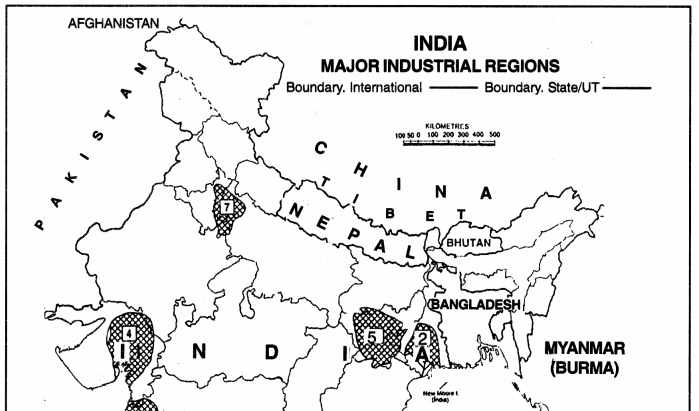
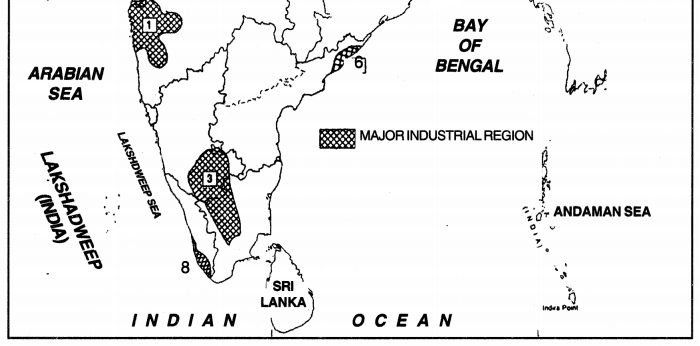
4. Madurai-Coimbatore-Bengaluru Region. This is the largest industrial region in Southern India. Many industries have developed at Chennai, Coimbatore, Madurai, Bengaluru and Mysore. This region has the following favourable factors:
- Cheap water power from Mettur, Pykara and Shivsamudram works.
- Cheap skilled labour is available.
- A huge local market.
- Favourable climate.
- Favourable climate.
- Raw cotton is available.
- Coimbatore has many industries like cotton textiles, coffee mills, leather tanneries and cement factories.
Bengaluru has Hindustan Aeronautics (Aircraft industry), Hindustan Machine Tools, Indian Telephone Industry, Bharat Electronics, etc. In other centres, Cotton textiles, Woollen textiles, Silk, Chemicals, Automobiles and Leather industries have developed.
5. Chottanagpur Plateau Region. This region has developed in Jharkhand-Odisha mineral region of Damodar valley. Many steel plants have been located in this region such as Jamshedpur, Bokaro, Durgapur, etc. This region is called ‘The Ruhr of India’. A number of factors have favoured the industrial development in this region:
- Coal from Jharia-Ramganj coalfields.
- Iron from Bihar-Odisha region.
- The facilities of port of Kolkata,
- Water power and thermal power from Damodar valley project.
- Many heavy industries and engineering industries have developed at Ranchi, Sindri, Chittranjan, Jamshedpur, Hazaribagh, etc.
6. Gurgaon-Deihi-Meerut Region. A number of industrial clusters have assumed importance after independence.
(1) These industries have developed in area adjoining to Delhi. One such industrial region has emerged between Agra-Mathura-Meerut and Saharanpur in U.P.
(2) Another parallel belt extends between Faridabad- Gurgaon-Ambala in Haryana. Both these belts merge in an agglomeration in the vicinity of Delhi.
(3) The hydro-electricity from Bhakra Nangal and thermal power from Harduaganj and Faridabad have very positively contributed to the industrial development of this region.
(4) Majority of the industrial units are agro-based, particularly sugar and textile mills.
(5) Glass, chemicals, engineering, paper, electronics and cycle are other important industries of the region.
(6) Main industries. Agra has glass industry, Mathura has an oil refinery with its petro-chemical complex. Gurgaon has a car factory as well as a unit of the IDPL. Faridabad has a number of engineering and electronics industries. Ghaziabad is a large centre of agro-industries. Saharanpur and Yamunanagar have paper mills. Modinagar, Sonipat, Panipat and Ballabhgarh are other important industrial nodes of this region.
7. Vishakhapatnam-Guntur Region. This industrial region extends from Vishakhapatnam district to Kurnool and Prakasam districts in the south. Industrial development of this region hinges upon Vishakhapatnam, and Machilipatnam ports and developed agriculture and rich reserves of minerals in their hinterlands. Coalfields of the Godavari basin provide power and energy.
Ship building industry was started at Vishakhapatnam in 1941. Petroleum refinery based on imported petroleum facilitated the growth of several petro-chemical industries. Sugar, textile, jute, paper, fertiliser, cement, aluminium and light engineering are principal industries of this region. One lead-zinc smelter is functioning in Guntur district. Iron and steel plant at Vishakhapatnam uses the ore from Bailadila.Vishakhapatnam, Vijayavada, Vijayanagar, Rajahumundry, Guntur, Eluru and Kurnool are important industrial centres.
8. Kollam-Thiruvananthapuram Region. This industrial region is spread over Thiruvananthapuram, Kollam, Alwaye, Ernakulam and Allappuzha districts. Plantation agriculture and hydropower provide industrial base to this region. Located far away from the mineral belt of the country, agricultural products processing and market oriented light industries predominate the region.
Among them, cotton textile, sugar, rubber, matchbox, glass, chemical fertiliser and fish-based industries are important. Food processing, paper, coconut coir products, aluminium and cement industries are important. Petroleum Refinery at Kochi is also useful. Kollam, Alluva, Kochi, Vishakhapatnam uses the Bailadila iron ore. Punalus is another important centre.
Manufacturing Industries Important Extra Questions HOTS
Question 1.
Account for the shifting of sugar industry towards southern India.
Answer:
Uttar Pradesh is the largest producer of sugar in India despite the fact that ideal conditions for sugarcane are found in southern India. But recently, the industry is shifting towards the states of Maharashtra, Tamil Nadu and Andhra Pradesh in Peninsular India.
- The yield per hectare of sugarcane is high in southern India
- The sucrose content in sugarcane is high in southern India as compared to that in(Solved))— northern India
- The southern states have installed new mills, where productivity is high and cost of productions is low.
- Climatic conditions are ideal in southern states
The co-operative movement has helped to install new mills in these areas.
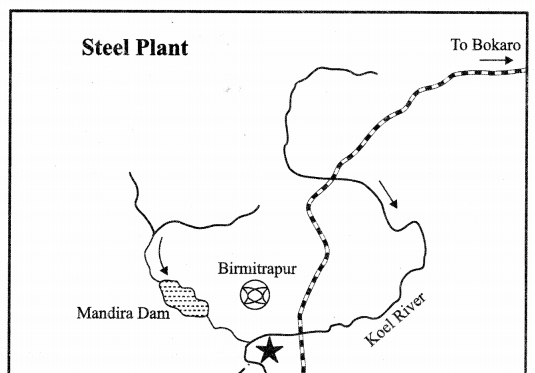
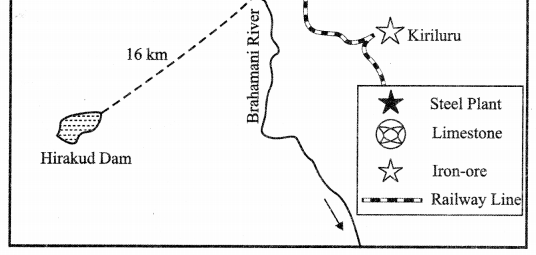
Question 2.
Study the diagram given below and answer the questions that follow:
(1) Name the State in which this iron and steel plant is located.
Answer:
Rourkela (Odisha).
(2) Name the sources of coal and iron-ore for this plant.
Answer:
Coal from Jharia and iron-ore from-Odisha.
(3) Explain the principle on which this plant was set up.
Answer:
This plant provided machinery and consultancy to the plant among others.